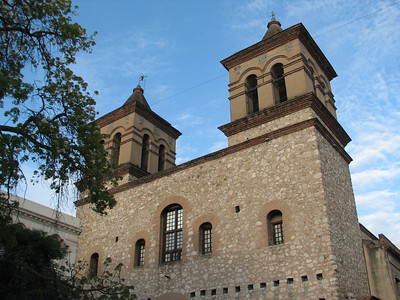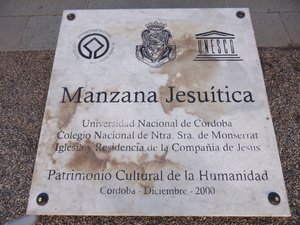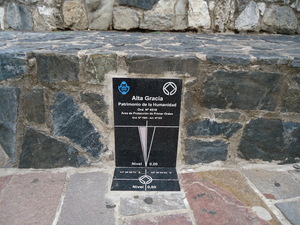Jesuit Block and Estancias of Córdoba

The Jesuit Block and Estancias of Córdoba comprise complementing urban and rural settlements that were developed by the Society of Jesus as part of their missionary activities.
In Córdoba proper, the Jesuits were allocated one of the blocks in the checkerboard plan of the city, where they built a university (Colégio Maximo), a college and a church that also held the Jesuit political/administrative bodies. The rural estancias, supported by complex hydraulic systems and worked by indigenous farmers and African slave labourers, were to provide the necessary resources through farming and textile production.
Community Perspective: Using Cordoba as a base, the estancias can be reached by adding one or two day trips by bus or car. Read Timonator’s review for the most recent info.
Map of Jesuit Block and Estancias of Córdoba
Community Reviews
Timonator

I have visited the Manzana Jesuítica and the crypta in Córdoba as well as the estancias Jesús María, Caroya and Alta Gracia.
I have really enjoyed staying a week in Córdoba because this big student city is lively as it's full of young people, good food and it's cheap.
The city center contains some highlights next to the WHS like the Cathedral and the Memorial place for the victims of the dictatorship in an old police station. The manzana jesuítica is the jesuit block in the town set-up and consists of a school, the law faculty of the university of Córdoba and the church. The university part is also a museum complex that can be nicely visited for currently 400 Pesos p.P.. We obtained a small bookled in German at the entrance and walked through the Jesuit rooms containing old books and maps. Also we asked a security guard to open the graduation hall which is the aisle of the church, but only accessible from the patio of the university. Finally we had a short look into the big and beautiful church during a mass.
Additionally during two day trips we went to Alta Gracia (35 km from Córdoba) and Jesús María (50 km from Córdoba). To Alta Gracia buses run from the new terminal and take about an hour. Companies are Sierras de Calamulchita and Sarmiento and prices are around 400 ARS per ride. Only during the night there are no buses. You can check times in advance on plataforma10.com.ar and buy tickets at the driver or at the counter in the terminals. Alta Gracia has a nice town center with a lake and the estancia, which has an self- audio guide tour in english for your phone. The Wifi wasn't working so best to use mobile data. The self-guided tour is interesting and gives some insights into life on the estancia. My highlights were a German Luther bible and the accounting book of the Jesuits, that I only heard about though as the door was closed for Siesta. As others before I can highly recommand the Che Guevara museum around the corner in his youth home that I found really interesting and touching.
In Jesús María there are two estancias that can be visited. Again there are two bus companies that run for 450 ARS currently from the old Terminal to the town often outside nighttime. The companies are Fono Bus and Ersa Bus and the counters to buy the tickets are downstairs in the old terminal (the one that is also for long distance buses). In Jesús María we got off the bus before the terminal next to the big unfinished highway bridge in order to walk to Caroya Estancia. There is a visitor center on the main road with information on all jesuit sites and with some general facts and baños. After reading through the signs we walked the few meters down the gravel road to visit the estancia. Before reaching the main building there are some remainings with explaination signs of the craft sites like an oven, a storage building, a mill etc.. The estancia building is well preserved and in each room there are information in chronological order in Spanish on the history of the building from Jesuit times to a visit of Belgrano in the independance wars until the Italian immigration wave during which immigrants stayed there. It's quite a lot of information and not all is interesting, but still it's worth a stop. It costs only 100 ARS currently. The woman working there was so kind to call us a taxi that brought us to the estancia Jesús María in town. There is a nice park and again some information signs in the building plus a church to visit that apparently was never finished in its interior due to the 1767 expulsion of the Jesuits. The collection of coins upstairs is nice- probably you will find some old coins from your country as well. The best part about our visit though was an art auction in the church and a free concert afterwards in the patio with indigenous sounds. Was a nice round- off of the visit.
It's nice to visit Córdoba and some of it's less touristy surroundings in a few days and it gives good insights into the history of the Jesuits in this area. Also everything is much better preserved than in Missiones and Paraguay. Nevertheless I find it's more an interesting WHS not a fascinating one.
Read more from Timonator here.
Michael Novins

In October 2017, I made a day trip by minibus from Córdoba to Alta Gracia, the location of one of the estancias. The minibus stopped in Alta Gracia's center, from where it was a short walk to Plaza Manuel Solares and the estancia. From the estancia, it was a 15-minute walk, the first part along the estancia's reservoir, to the Museo Casa de Ernesto Che Guevara, where the world's most famous revolutionary lived in the 1930s. I also visited the Jesuit Block in Córdoba, which is now home to the city's natural history, paleontological and botanical museums, as well as a church and library.
Michael Turtle

There are some interesting little details to see within the block. The designs on the walls are unique to this part of the world because of the way they fused together the Spanish view of Christianity with the connection to nature of the indigenous people; The architect of the church was a boatbuilder by trade and so the ceiling of the building resembled the hull of a ship; The university’s collection of books includes a very rare complete bible from 1645 written in seven different languages.
Cordoba overall is quite a fun little city and this is a worthwhile sight within it.
Read more from Michael Turtle here.
Chris W.
I visited in early October 2015. And I do not agree with Els. Sorry !
Cordoba is yes a working city, but it's also a university city and has a large area (triangle around the Jesuit Quarter) with lots of restaurants, bars and other places to spend some time. I loved the university and it's architecture; make sure you do the guided tour to visit the inside.
Then the estancias, I saw all. The idea was to see all in one day but I kind of choose the adventurous route through the mountains to the Candelaria. I understand after driving why my navigator said 4x4 only; i was in a simple city car. If you stick to the paved roads you COULD see all 5 in a day. But better Alta Gracia on a seperate morning or afternoon. I do agree tha tone was the less interesting. the others were must better.
please see the link for all photos an my full adventurous story including GPS track how to drive it most quickly.
Read more from Chris W. here.
Thomas Buechler
Cordoba is well worth a stop, but dont plan it on a Sunday, because everything is closed then, except the many churches of course which are very much alive on a Sunday. The highlights among the Unesco world heritage sites was the visit to the Jesuit library with ist amazing collections of ancient books. At one stage, this collection reached more than 6000 volumes, but after the expulsion of the Jesuits ordered by the Spanish Crown, lots of books went missing, and some ended up in the National Library in Buenos Aires.These books date from the early XVIth century onwards, and were written i n Latin, Greek, Spanish etc, as well as in vernacular languages like Quechua.Some are richly decorated with copper engravings and woodcuts.I have seen a fine example of a justice book dating from 1539 written in Basel, Switzerland.
The latest addition to the Jesuit library is the collection of ambassador Ferrer Vieyra which was donated to the museum in 2001.It consists of 387 beautiful books, among them are 22 incunables that were printed before 1500 and are out outstanding historical significance.
Other places that you should include in your visit are the Manzana Jesuitica, La Compania and the Capilla Domestica that was closed this time for renovation. The main Cathedral on beautiful Plaza San Martin has a richly decorated interior, attractive stained glass windows, and a wonderful ceiling.
We also did the half day trip to Alta Gracia, take Sarmiento buses from the Minibus terminal in Gordoba for the 45 minutes trip.Visit the Estancia Jesuitica and the Ernesto Che Guevara museum where the young revolutionary lived in his childhood.
Roberto
I visit this site twice and i as the "Justification for Inscription" said "The Jesuit buildings and ensembles of Córdoba and the estancias are exceptional examples of the fusion of European and indigenous values and cultures during a seminal period in South America. The religious, social, and economic experiment carried out in South America for over 150 years by the Society of Jesus produced a unique form of material expression, which is illustrated by the Jesuit buildings and ensembles of Córdoba and the estancias".
The main church in Córdoba city was built as a ship, and was one of the wonder of than time in the area. The "estancias" are fines examples of Barroco local stile. In Alta Gracia we saw also a Che Guevara´s house museum, and Manuel Falla´s house.
For me is a very interesting site, i a marvellous area.
Els Slots

Every trip has its day or location where one feels to have hit rock bottom (at least my trips do). This time the honour goes to: Cordoba! I didn't like Cordoba at all - it's a working city crumbling at all edges. I had the worst hotel of my stay, and even the worst food (which is difficult in Argentina). I was shortchanged by a taxi driver here for the first time this trip (but was alert enough to see his trick, returning 2 pesos instead of 20).
I did a quick visit to the Jesuit Block in the city center. It is located in the pedestrian area, among other more colourful churches. The WHS designated buildings all have displays telling some of their history. They are now in use as a regular University and Church. You can have a look inside, but I wasn't overwhelmed.
To escape the bad city vibes I took a local bus to Alta Gracia, one of the estancias included. The driver dropped me off at what I first thought was a nice city park with a lake, but turned out to be the tajamar, the water reservoir constructed by the Jesuits for irrigation. At the other end of the park is the pretty Baroque church. And next to that, El Obraje: a former mill that now is a school (where kids took classes half in the open). Well, that was about it. I hope others can write more imaginative stories about the Jesuit Block and Estancias than I can.
Iain Jackson
I visited this site in January 2003. The weather was warm and sunny for the 3 days I was in the area.
I went first to Alta Gracia, tumbling off the overnight bus from Buenos Aires which, confusingly, goes first to Cordoba before heading back south to Alta Gracia. It is a charming small town,home of Che Guevara for several years, with the estancia at its heart next to the Tajamar, the artificial lake built to provide water to the surrounding lands.
The estancias have a similar layout, built round a large yard with one side dominated by a church. They lie at the centre of the large estates, the income from which, and from the associated trades and crafts, was used to finance the building and development of the Jesuit block in Cordoba
It was only when I got to Cordoba that I realised that the "block"(or Manzana-"apple"?) in this case is the large city block allocated to the Jesuits when the city was laid out.
Cordoba, like so many Spanish colonial cities is built on a gridiron pattern. Aside from the, to be expected, religious buildings the principal use of the Block is for the University, the oldest in Argentina. Some handsome buildings here.
I reckoned Candelaria, 220kms from Cordoba, and with no public transport links, was beyond my reach, but next day I took a guided tour by minibus to the 3 other estancias. All had their own attractions. Santa Catalina is said to be the largest and the only one now in private ownership. Access is allowed only to its white painted, lofty church. Jesus Maria dates from 1618, is famed for its wine and has an excellent Jesuit Museum. Lastly Caroya has a picturesque rural setting its beauty enhanced, when I was there, by the late afternoon sunlight slanting across its buildings.
In my view this is a site well worthy of its status and, for those of us who like to get a bit off the beaten track, one that amply rewards the visitor.
Community Rating
- : Michael anak Kenyalang GZ
- : KeithBailey Christravelblog
- : Thibault Magnien Rvieira
- : Gianmarco Kurt Lauer Wojciech Fedoruk Timonator Mikko Krijn Alexander Lehmann Thomas van der Walt Carlos Sotelo Feldhase Kevin247 Frédéric M
- : Alejandro Lau Jean Lecaillon Shandos Cleaver
- : Gary Arndt Doubanjiang Yuri Samozvanov Tevity João Aender Ammon Watkins Els Slots
- : Stanislaw Warwas Zoë Sheng
Site Info
Site History
2000 Inscribed
Site Links
Connections
The site has 11 connections
Art and Architecture
Religion and Belief
Science and Technology
Timeline
Trivia
WHS on Other Lists
World Heritage Process
Visitors
97 Community Members have visited.
The Plaque
 (photo by Jarek)
(photo by Jarek) (photo by Jarek)
(photo by Jarek)